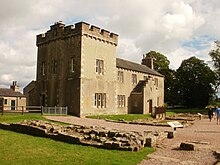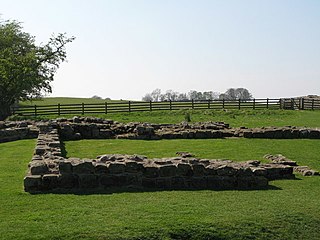
Birdoswald is a former farm in the civil parish of Waterhead in the English county of Cumberland. It stands on the site of the Roman fort of Banna.

Birdoswald is a former farm in the civil parish of Waterhead in the English county of Cumberland. It stands on the site of the Roman fort of Banna.
Birdoswald first appears in the written record in 1211 when Walter de Beivin was farming the property, then part of the Barony of Gilsland. He gave land in the area to Lanercost Priory and his nephew Ralph de Birdoswald indicating he had a house there. It was a convenient location, for the thick stone walls of the old Roman fort subsequently provided protection for generations of farmers in a Scottish border area that remained marginal and dangerous territory. By 1425, the farm was in the hands of the Vaux family who were probably the builders of a large pele tower found during excavation. The old Roman west gate was also still in use at this time, but it had collapsed by the end of the century.
In the 1580s, the farm was home to the Tweddle family who replaced the pele tower with a bastle house, a common form of border farmhouse with living quarters on the first floor above a livestock barn at ground level. It was the best defence against raids from neighbouring reivers. In fact the Tweddles themselves were probably reivers for Robert and Hobbe Tweddle appeared in typical reiver dress at a 1581 muster. They were certainly attacked on a number of recorded occasions by the notorious Elliot and Nixon families from Liddesdale. The door to their bastle house was hacked down and burnt and numerous cattle stolen. Even during such troubled times, the site of the Roman fort was visited by an early antiquarian, Reginald Bainbridge.

In the late 17th century, the basis of the present farmhouse was built. The main part of the building was added in 1745 by Anthony Bowman and his wife, as still recorded on an inscribed stone. The antiquarian, John Horsley, visited the site not long before and William Hutton was there in 1802. In 1830, Thomas Crawhall bought the farm and, ten years later, Henry Norman. Both were interested in the old fort and instigated excavations. In 1858, Norman turned a rather plain farmhouse into a somewhat grander building, complete with mock medieval pele tower. The property was later sold to Lord Henley and let to tenants. The last of these left in 1984, when the farmhouse became a youth hostel and museum and much of the Roman fort was laid out for public display.

Edlingham Castle is a small castle ruin, having scheduled monument and Grade I listed building status, in the care of English Heritage. It is located in a valley to the west of Alnwick, Northumberland, England. It has been described as "...one of the most interesting in the county", by Nikolaus Pevsner, the architectural historian. Edlingham itself is little more than a hamlet with a church alongside the castle.

Peel towers are small fortified keeps or tower houses, built along the English and Scottish borders in the Scottish Marches and North of England, mainly between the mid-14th century and about 1600. They were free-standing with defence being a prime consideration of their design with "confirmation of status and prestige" also playing a role. They also functioned as watch towers where signal fires could be lit by the garrison to warn of approaching danger.

Bastel, bastle, or bastille houses are a type of construction found along the Anglo-Scottish border, in the areas formerly plagued by border reivers. They are fortified farmhouses, characterised by security measures against raids. Their name is said to derive from the French word "bastille".

The River Irthing is a river in Cumbria, England and a major tributary of the River Eden. The name is recorded as Ard or Arden in early references. For the first 15 miles of its course it defines the border between Northumberland and Cumbria.

Haltwhistle is a market town and civil parish in Northumberland, England, ten miles east of Brampton. It had a population of 3,811 at the 2011 Census.


Arthuret is a civil parish in the Carlisle district of Cumbria, England. According to the 2001 census it had a population of 2,434, increasing to 2,471 at the 2011 Census. The parish includes the town of Longtown and the village of Easton. It is bounded by the River Esk to the west and the River Lyne to the south.

Pevensey Castle is a medieval castle and former Roman Saxon Shore fort at Pevensey in the English county of East Sussex. The site is a scheduled monument in the care of English Heritage and is open to visitors. Built around 290 AD and known to the Romans as Anderitum, the fort appears to have been the base for a fleet called the Classis Anderidaensis. The reasons for its construction are unclear; long thought to have been part of a Roman defensive system to guard the British and Gallic coasts against Saxon pirates, it has more recently been suggested that Anderitum and the other Saxon Shore forts were built by a usurper in an ultimately unsuccessful attempt to prevent Rome from reimposing its control over Britain.


The history of Cumbria as a county of England begins with the Local Government Act 1972. Its territory and constituent parts however have a long history under various other administrative and historic units of governance. Cumbria is an upland, coastal and rural area, with a history of invasions, migration and settlement, as well as battles and skirmishes between the English and the Scots.

Barmkin, also spelled barmekin or barnekin, is a Scots word which refers to a form of medieval and later defensive enclosure, typically found around smaller castles, tower houses, pele towers, and bastle houses in Scotland and the north of England. It has been suggested that etymologically the word may be a corruption of the word barbican or berm. The barmkin would have contained ancillary buildings, and could be used to protect cattle during raids.

Clifton Hall was a fortified manor house in the village of Clifton, Cumbria. Dating from around 1400, it was constructed by either Elianor Engaine or her son-in-law William Wybergh, and was held by the Wybergh family until the 19th century. Initially taking the form of an "H"-plan design built around a central hall, around 1500 a three-storey stone pele tower was added, providing both additional security and acting as a status symbol for the family. At the start of the 17th century a new stone hall was added to the south of the tower.

Upper Denton is a small village and civil parish in the north of Cumbria, England, about 1 km north of the A69 road linking Haltwhistle and Brampton. The population of the civil parish when taken at the Census of 2011 was less than 100. Details are included in the parish of Nether Denton. The village is situated on the line of the Roman Stanegate road which ran from Corbridge (Coria) to Carlisle (Luguvalium). Just 1 km to the north across the river Irthing is Birdoswald fort on Hadrian's Wall. Nearby villages include Gilsland, Greenhead and Lanercost.
Camboglanna was a Roman fort. It was the twelfth fort on Hadrian's Wall counting from the east, between Banna (Birdoswald) to the east and Uxelodunum (Stanwix) to the west. It was almost 7 miles (11 km) west of Birdoswald, on a high bluff commanding the Cambeck Valley. It guarded an important approach to the Wall and also watched the east bank of the Cambeck against raiders from the Bewcastle area. The site was drastically levelled in 1791 when the gardens of Castlesteads House were laid over it. The name "Camboglanna" is believed to mean "Crook Bank", or "Bent Valley" because it overlooks a bend in the river Irthing; the name is Brythonic, made of cambo- "curved, bent, crooked" and glanna "steep bank, stream/river side, valley with a stream".

Bewcastle Roman Fort was built to the north of Hadrian's Wall as an outpost fort possibly intended for scouting and intelligence. The remains of the fort are situated at the village of Bewcastle, Cumbria, 7 miles (11 km) to the north of the Roman fort at Birdoswald, on Hadrian's Wall.

Black Middens Bastle House lies about 7 miles (11 km) northwest of Bellingham, Northumberland. It is a two-storey fortified stone farmhouse from the 16th century. In times of trouble from border reivers, which were common on the English-Scottish border, farmers could hide behind its thick walls. Livestock would be kept downstairs and the farmers' families upstairs.
Whitley Castle (Epiacum) is a large, unusually shaped Roman fort north-west of the town of Alston, Cumbria, England. The castrum, which was first built by the Roman Army early in the 2nd century AD, was partly demolished and rebuilt around 200 AD. It appears to have been sited to protect lead mining in the area as well as to support the border defences of Hadrian's Wall.

Milecastle 50TW (High House) was a milecastle on the Turf Wall section of Hadrian's Wall (grid reference NY60716583). The milecastle is located close to the Birdoswald Roman Fort and is unique in that it was not replaced by a stone milecastle when the turf wall was upgraded to stone, the replacement wall instead running some 200m to the north. The milecastle was partially demolished by the Romans after it was abandoned. The milecastle was excavated in 1934 and several Roman rubbish pits discovered. The remains of the two turrets associated with this milecastle (which were demolished when the turf wall was abandoned) have also been located. As the turf wall lies some distance from the stone wall, the sites are not accessible from the Hadrian's Wall Path.

The Lowbridge Estate is a country estate of approximately 2000 acres in the Lake District region of England that was in the continuous ownership of the Fothergill family from 1761 to 2016. It is now the home of the Todd family. Lowbridge House, the principal house on the estate, was built in the 1830s by Richard Fothergill II (1789–1851) in the cottage orné style. The property was substantially updated and improved in 1889 and again in 2017 to 2019. The property lies between Todd Crag and Bannisdale. Other properties on the Estate include Lowbridge Cottage, Lowbridge Lodge and the Bridge House. The Estate has become a haven for red squirrels with a very active policy of conservation including the extensive planting of red squirrel friendly larch trees and the reintroduction of pine-martins.